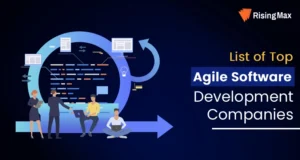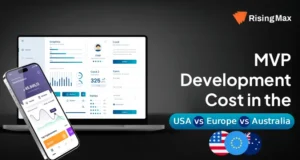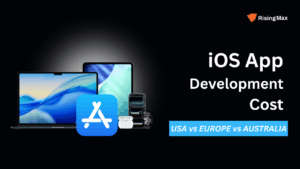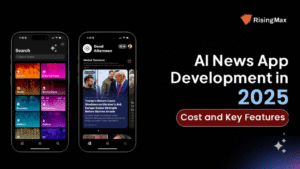It’s 2025-(26), and going digital doesn’t just mean having an online presence. You can have a full-fledged business running digitally on software.
But if you are new in this $4.1 trillion digital arena, it can be a little tricky to choose a starting point.
Even if your idea solves the demand of the people, its righteous implementation plays a big role in its success. And why does it matter? Over 5 million new businesses launch annually in the USA!
So what’s unique about your approach, and is your framework reliable?
Well, in this blog, we are covering 12 money-making tech startup ideas that are leading the digital trend in the USA, along with their revenue streams and market potential.
How to Pick a Business Idea That Can Be Scaled with Technology
First, let us understand what it means to scale a business idea with technology.
What’s Scaling a business using Technology?
Say you are running a local restaurant all by yourself.
Even if you want to, there’s a market cap beyond which it would become impossible for you to make more profit out of it.
Now, you have hired some chefs and automated your administrative work. This way, you can cater to more people in a day. Again, after a certain limit of customers or demand, things will start falling out of hand.
But now automate some parts of it. Such as online booking, home delivery, automated billing, etc, this way, without the requirement of heavy infrastructure, you can cater to a much wider audience.
Market cap in this strategy? Well, think about McDonald’s. Think of its automation, scalability, and the revenue it generated today!
That’s scalability using Technology.
But how to pick a business idea that is scalable using technology? Here it is!
Validate Demand with Real-World Problems
Like any other startup plan, it is important to identify the niche you are interested in or have related experience in. Then work on identifying loopholes in it.
For example, Klarna Like App – BNPL (Buy Now Pay Later) based fintech service provider. Back in 2005, the founders knew the trust gap between customers and e-commerce stores. Therefore, they created a medium in which users can purchase instantly, the intermediary platforms (Klarna) pay on behalf of buyers, and later on, customers pay directly to Klarna.
Evaluate How Tech Can Solve It Efficiently
Another important point to consider is to find ways through which the tasks can be efficiently done when compared to manual efforts. Think of analyzing and sorting the data of 10K customers using various parameters will be a huge task for any person. But for AI, that can be done in less than a minute.
Consider Monetization: Subscriptions, Ads, Services
Once you have the above two points cleared in your mind, you can focus on making revenue out of it.
Look for various means through which you can maximize your profit. If the same service can cater to different audiences without overlapping, consider pushing to both audiences.
Revenue streams based on a subscription model can generate a good amount of FIXED revenue.
Prioritize Niches with Repeat Use or High Retention
It’s a no-brainer that selling to a new customer is always difficult than to an existing one.
Go for a niche that has a higher retention rate and a repeat customer base (subscription model). OTTs are the best examples of such niches. Simply remember that OTTs are not the only software startup ideas that have repeated use and a higher retention rate.
12 App & Software-Based Money Making Business Ideas in USA
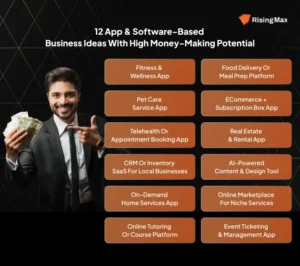
In this guide, we will cover the market scope of these startup ideas, revenue generation ways, earning potential, and some unique ideas that you can consider to start smart and scale fast.
Heads up, you are about to step into some real business!
1. On-Demand Home Services App

As per Grand View Research, the US online home services are expected to cross USD 3,636.9 million by 2030. Demand for such services is increasing substantially in US suburban areas.
The business model is simple: a multi-vendor platform in which professional service providers list out basic services such as plumbing, cleaning, repairs, cleaners, or handymen. Users then book/schedule an appointment online. Some of the examples include TaskRabbit and Handy.
Here’s how an on-demand home service app works:
- User opens the app and chooses the required service
- Real-time search happens to locate nearby service providers
- Users compare the prices and quotes.
- Book service, pay through app, and get assistance
After completion, both parties can also give reviews to each other.
Gen Z and Millennials are the primary users of such services, as they like the comfort and flexibility that comes along.
Here’s how you can maximize your revenue from an on-demand home service app:
- Commission on each transaction processed.
- Subscription plans for users offering priority services.
- Affiliates Campaigns, such as featured listings.
If the model is executed properly, it can generate between $2M – $5M annually in a mid-sized US city. Note that these are the rough estimations!
Unique Ideas that you can add to beat the current market:
- AI-based matching as per ratings, location, budget, and past preferences.
- AR (Augmented Reality) integration to give service providers an idea about the issues.
- Consider providing bundle services at discounted rates.
Well, if you are more of a fitness guru, then our next recommendation is just for you.
2. Fitness & Wellness App

Fitness and wellness aren’t a business but a lifestyle. Therefore, if you have expertise in a related field, you can provide yoga classes, guided meditation sessions, or even personal workout plans.
Even if you don’t have expertise in giving fitness and wellness classes, you can opt for a marketplace platform. The structure of the marketplace platform remains similar to the previous one we discussed.
How fitness and wellness apps work: Users’ data is collected along with their preferences, health monitoring, and personalized recommendations based on their preferences.
Furthermore, you can also provide subscriptions for premium services or to access sessions, classes, including separate charges for 1-1 sessions.
The global fitness app market is growing at a rapid rate of 13.88% (CAGR) and is expected to cross USD 23.21 billion by 2030.
Given the highly competitive nature of this money-making business idea, you should combine a tracking and monitoring model with other add-on services such as diet planners, habit trackers, 24*7 AI coaches, etc.
Here’s how you can maximize the revenue of the fitness & wellness app:
- Free version + Subscription-based App.
- In the free version, you can post affiliate ads and charge accordingly.
- On-demand Personalized workout, meditation, or yoga session.
- Extended integration with smart devices to retain users and boost active time.
- AI-assisted diet planner and tracker.
- Allowing niche-related e-commerce stores to integrate and sell products. Earn by charging commission.
The wellness sector has great earning potential, as you can target a worldwide audience. Established fitness & wellness brands such as MyFitnessPal and Strave earn revenue between $9 million $16 million.
3. Food Delivery or Meal Prep Platform
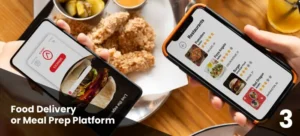
You might have heard of/used Uber Eats or DoorDash once in a while. Our next recommendation is something similar. Unlike other premium services, this business model has good scope in even Tier 2 cities.
Working mechanism of food delivery or meal prep platforms:
Users browse meals or restaurants.
Features used – location-based services, preference filters
↓
Add orders to the cart.
↓
Proceeds with the payments.
↓
Order Tracking/ Cancellations stage
↓
Receives order and leaves a rating.
Since the existing platforms already have deep market penetration, you should aim towards a more specific audience, such as a dedicated app for vegans, keto diets, or by partnering with local chefs.
Since there will be multiple participating players to ensure the smooth functioning of the platform, this increases the complexity of app design.
App developers need to focus mainly on these 4 sides:
- Buyers’ Side Interface & Functioning
- Merchant (i.e., Restaurant or Chef) Side
- Delivery Partner Side Controls and Interface
- Admin Panel for platform management.
It is already a trillion-dollar industry with giants like DoorDash having a current revenue of $1.040 trillion.
And if you are looking for more of a trendy tech startup idea, then check the one below!
4. Online Tutoring or Course Platform

With projected revenue of around $60.25 billion in 2025, online tutoring platforms have completely revolutionized learning patterns.
An online tutoring or Course app provides a platform where teachers and students can interact with each other via video call, chat, or conference calls. This way, a teacher can take a personalized 1-1 session or a group session without going anywhere.
Similarly, on a course platform, teachers can upload a pre-recorded training module or even take live sessions to teach students.
Here’s how eLearning apps work:
- Registration from the learners/teachers’ end, both creating a profile and sharing their aspirations/expertise.
- Based on the saved preferences, the algorithm recommends preferred courses to students.
- Through in-app communication, both can interact via different means.
- Once the learner decides upon the course, they can proceed with payments and access the course in full.
Chegg, Tutor.com, TutorMe, and Preply are some of the common platforms offering modern eLearning solutions.
Talking about revenue streams, you have several different options to choose from:
- Platforms may charge tutors a commission on every sale of their courses/modules.
- Two-way subscription model for both learners and tutors with a dedicated set of benefits.
- Offer advertisement/ featured listing options to tutors to promote their courses.
- Furthermore, you can also offer a white label LMS to schools and institutes.
The EdTech industry has already proven that eLearning startups have the potential to go up to IPO level growth. However, with the rise of personal tutors’ portfolios, the market is becoming quite competitive over time.
You can work on these ideas to set yourself apart from the current market:
- AI-assisted chatbots to provide 24/7 personalized learning with revision quizzes.
- Collaboration with the community – a step towards a virtual school or classroom.
- Adaptive pricing so that economically weaker students can also be included.
- Custom scholarship programmes.
- An advanced learning mechanism for supporting impaired and disabled learners.
5. Pet Care Service App

This one is for pet lovers.
A pet care service app is a platform where pet owners can book services such as sitters, dog walkers, groomers, and vets for their pets. You can further extend these services to provide telemedicine, pet healthcare, or track health from the app.
According to the American Pet Products Association (APPA), total U.S. pet service expenditure is valued at $151.9 Bn in 2024. The market value itself shows the potential of this U.S. startup Idea.
Another fact that makes this tech business idea a good option to pursue is its user base.
| Pet Ownership by Generation | |
| % of Pet Owners | |
| Gen Z | 20% |
| Millennial | 30% |
| Gen X | 25% |
| Baby Boomer | 25% |
*Data taken from APPA.
As evident from the stats, this startup plan has the most balanced user base, with the upcoming generation already accounting for 50%. It is clearly deductible that this industry is not only booming but also stable.
Even market brands such as Rover and Wag, which provide on-demand pet service, are expected to grow at a 10-12% CAGR.
Core Features to integrate if you are thinking about building one:
- User profiles for pet owners and service providers.
- Service booking.
- Notification alerts for active tracking.
- GPS tracking – an important feature for the dog walker service.
- In-app communication channel.
- Payment method.
- Community and review features.
- Emergency assistance.
You can also deploy AI/ML for more advanced features such as pet health tracking mechanisms, symptom trackers, or predictive analytics.
6. eCommerce + Subscription Box App

Our next recommendation is e-commerce, which is already booming in the US market. You can choose a specific product and target audience to sell it. Consider e-commerce as an online version of your store.
With profitable ideas such as dropshipping, you have a wide variety of products to choose from and won’t have to worry about their production. By outsourcing production, you can act as a marketeer and earn on a commission basis.
eCommerce Apps can include:
- Virtual or physical products that one can deliver online.
- Sell curated boxes such as snacks, beauty, books, etc.
- AI-based renewals for ordering essential items monthly or bi-monthly basis.
By integrating AI for subscription commerce, you can place yourself at the sweet spot of this trending industry.
Even a niche-specific eCommerce store, such as vegan snacks or grooming kits, has the earning potential of anywhere between $1 – 5 million within 2-3 years.
Some inspiring brands in this niche include:
- Birchbox – Curated beauty product subscription.
- SnackCrate – International snack subscription box.
- Book of the Month – Subscription for curated books.
- Dollar Shave Club – Grooming products.
This business idea has the most revenue streams. You can maximize your revenue by:
- By selling products.
- Adding a subscription or premium membership for added benefits. (E.g., Prime membership)
- Affiliate marketing
- Brand Partnerships
And the advantage here is that you can save a good amount of margin in each of these revenue streams.
You should note that this is already a booming industry and highly competitive. So either you need to launch a unique product set in the market or fill the gap that current players are missing.
For this, you can work on ideas such as,
- Lucrative awards for referrals.
- Point system for unboxing, reviews, etc. Those points can be used to purchase a new order, buy a membership, etc.
- AI-based recommendations for repetitive essential orders to make the bundle more attractive.
- Promoting local vendors, i.e., taking their unique skillset/product online by providing them a platform. A win-win situation for both you and the vendors.
7. Online Marketplace for Niche Services
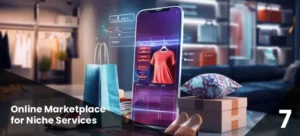
The gig economy has already become a significant portion of a developed nation.
Consider an online marketplace as an upgraded version of the previous one. But here, instead of selling products by yourself, you are providing a platform where vendors/service providers and earn on a commission basis.
Some of the good examples of this kind of business idea are: Etsy for handicraft products, TaskRabbit for handyman service, Upwork for freelancers, and Airbnb. All of these brands provide a specific/niche-based service.
Analyzing the current market scenario, you should look towards a hyperlocal service or an underserved niche.
There is no generalized strategy for this idea. Depending on the niche selection, revenue streams and implementation strategy will vary.
You may refer to some of our case studies to go deeper into online marketplace ideas!
8. Telehealth or Appointment Booking App

Do you know as per Fortune Business Insights, the Telemedicine market is projected to go from $111.99 Bn to $334.80 Bn between 2025 and 2032?
That’s more than $200 Bn growth in the industry in just 6 years of projection. So you know the potential of investing in this type of tech business idea!
The telehealth industry initially started as a platform through which patients could book appointments, thereby cutting down queue time significantly. But now it has diversified into a proper eHealthcare system.
A telehealth app is basically a medium through which doctors and patients interact with each other and provide/request online health services. These services may include:
- Scheduling appointments
- AI Symptom Checker
- Routine Checkup Reminders
- Automated track of medicines
- Telemedicine Video Conferencing
- Digital Prescription
- Pharmacy Integration
- Insurance claims and prescription sync
- Personal Health Records and EMR (electronic medical records)
- Healthcare Wearable Integration for real-time health monitoring
It is important here to note that, since telemedicine is one of the YMYL niches, it is important to opt for government compliance, such as HIPAA. Also, such apps include the exchange of personal data; therefore, app development might get costly and complex.
Based on the model of your telemedicine app, you can generate revenue by:
- Commission based on appointments.
- Subscription model for patients and doctors
- Partnering with healthcare facilities to provide EMR.
- In-app advertising
- Partnership with medicine distributors.
9. Real Estate & Rental App

If you have ever looked for a rental property or bought a new one, you might have come across Zillow or Realtor.com!
That’s the next tech startup idea!
In a real estate or rental app, you act as a facilitator, simplifying the hunt for a new property prior to making any ground efforts. This platform cuts down a significant amount of time and effort in finding a new property.
By choosing filters of your preferred location and price range, you can directly schedule a visit to the property without burning extra fuel.
The US real estate market is expected to reach US$136.62 trillion by 2025. That’s by far one of the most successful market sizes from all of the discussed startup ideas for the US market.
You can aim to provide services such as:
- Buy/sell/rent properties through an online platform.
- Virtual home tours.
- Communication channel between dealers and buyers.
- Local agency branding.
- Negotiation chat
- Visit scheduling
- Rental agreements
To add more value or to bring uniqueness to your app, you can offer AR (Augmented Reality)/VR (Virtual Reality) features for immersive property tours.
In this idea, too, you can have multiple earning sources:
- Charging listing fees to property owners or dealers.
- Commission model on successful deals (however, less customer-friendly)
- Subscription to view posted properties or to contact property owners.
- Advertisements.
- Featured listing.
- Partnering with loan processing firms.
Even at a city scale, you can take your business to $3-5 million within 2-3 years.
10. Event Ticketing & Management App

We all know how important connecting with people is in this digital world.
Well, the next recommendation is something on which many businesses rely.
In simpler terms, event ticketing and management apps help in organizing events, communicating with the audience, and helping organizers to smoothly plan the whole event.
You can opt for providing software to organizations (in layman’s terms, think of CRM software) or make a platform where organizers can publish their events, and then the audience signs up for those events.
Heard of Eventbrite or Ticketmaster? Well, these are startup ideas we’re talking about here!
Features that you can consider adding are:
- Buy/Sell tickets for concerts, meetups, shows, or even workshops.
- QR code entry/exit.
- Managing the Guest/attendees list.
- Tiered Pricing.
- Calendar sync and location services
To maximize the revenue, you have the following options:
- Commission on tickets.
- Paid events listing with freebie model (Say 3-5 events free each month, then paid).
- Subscription model for frequent organizers
- Advertisement to promote a specific event.
- Premium features such as early bird discount, VIP ticketing, etc.
- Provide white label solutions to other organizations.
11. CRM or Inventory SaaS for Local Businesses
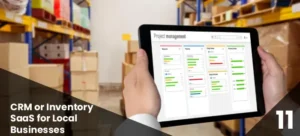
So far, we have discussed ideas that included taking a traditional brick-and-mortar store online.
But have you thought about how offline stores will manage their client, products, and sales data?
Well, the idea is to provide a convenient platform for businesses to manage all of the data related to their workforce, leads, products, clients, and so on.
Such platforms are called CRM (Customer Relationship Management) software.
A CRM allows a business owner to manage and track customer interactions with their business. It provides key data and insights regarding the sales pipeline, lead generation data, and how to fast-track sales or set a personalized tracking agenda.
Moreover, a CRM can save you from tons of manual work, such as billing and inventory management. By automating such tasks, you can focus more on growth.
You will be surprised to know that more than 80% of the US local businesses are using SaaS in one form or another. So you can target restaurants, retail shops, and salons. Lightspeed and Zoho Inventory are excellent examples of such services.
Here are some of the revenue streams that you can combine to maximize the profit from CRM or Inventory SaaS:
- Tiered Pricing plans as per various needs/size of the business.
- Usage-based pricing
- Dedicated support for enterprise-grade clients
- Implementation and setup charges
- AI/ML integration options for data and lead analysis, giving businesses a ready-made automated solution to help them with tedious data.
Some unique ideas to set yourself apart from current market solutions:
- Pre-built industry-specific dedicated templates.
- WhatsApp/Instagram integration so that businesses can send invoices, details directly to customers.
- AI inventory tracking mechanism for owners.
- Business expansion opportunities for businesses and vendors to connect.
12. AI-Powered Content & Design Tool

Like the previous one, this tech-enabled business idea is to help brands boost their online presence.
Maintaining online profiles of businesses directly impacts their revenue. This demand creates a gap in terms of publishing content for their brands.
By creating AI-powered content and design tools, you can help businesses generate:
- Articles and blog posts.
- Industry-related Insights.
- Logos and social media posts.
- AI-generated video content.
Using this strategy, you are not only helping brands to increase their revenue but also attracting and retaining clients. This factor also makes it one of the highest scalable ideas compared to other app-based business models.
Canva, Looka, Jasper AI, and ChatGPT are some good examples to take inspiration from.
Why Tech-Enabled Businesses Are Booming in the USA?
A tech-enabled environment promotes innovation and opens up access to a much wider audience. As per the Valtech Study, “75% of business leaders believe that investment in digital transformation is necessary within the next 12 months.”
This initiative is not only fueled by users but also by the capitalists. Tech enables them to generate new streams of revenue.
Here are the primary factors behind this transformation:
Rise of Mobile-First Users
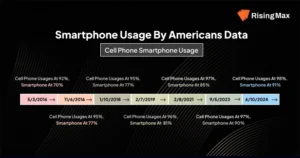
*Data taken from Pew Research Centre.
America has witnessed a steep rise in mobile-first users. Now the customer expects more convenience and maximum services right at their fingertips. This change in behavioural pattern has increased the scope of the digital market exponentially, with Gen Z and Millennials being the driving forces.
Automation, Convenience & Digital Expectation
Technology not only offers convenient options to consumers but also to business leaders. It helps them automate tedious, repetitive, or large amounts of data accurately and much faster.
Better Scalability with Apps & SaaS
The moment you take your business online, you instantly open it up in front of a global audience. And as your audience grows, you can easily scale up your model without the requirement of heavy infrastructure. Additionally, if your tech startup is subscription-based, then you get recurring revenue from the loyal customers, leading to more stable income.
Investor & Market Preference for Tech Startups
Given the potential of tech-driven startups and their low-investment, high-return model, investors are keen to invest in them. North America alone accounts for 70% of global investments in startups, making the US a suitable ground for both sharks and founders.
How Much Does It Cost to Build These Apps or Software?
Next comes the investment.
The cost of building a software or an app entirely depends on:
- The level of its complexity.
- MVP(Most Viable Product) vs Full-Featured vs Enterprise-level solution.
- Technology Stack Chosen (React Native can cost less, while Swift+Kotlin will perform better but cost more).
- Cross-platform compatibility.
Additionally, ongoing costs may also be incurred depending on the services, such as database, cloud storage, server, maintenance, etc.
Here’s a rough idea about the cost estimation. Note that these estimations are based on the USA market; actual costs may differ depending on the region, app type, and several other factors.
| Software Idea | MVP Product Cost | Full Product Cost | Enterprise-Grade Solution Cost |
| On-Demand Home Services App | $20,000 – $30,000 | $50,000 – $80,000 | $100,000 – $200,000+ |
| Fitness & Wellness App | $20,000 – $40,000 | $70,000 – $120,000 | $150,000 – $300,000+ |
| Food Delivery / Meal Prep Platform | $25,000 – $50,000 | $80,000 – $150,000 | $200,000 – $400,000+ |
| Online Tutoring / Course Platform | $20,000 – $50,000 | $80,000 – $140,000 | $180,000 – $350,000+ |
| Pet Care Service App | $15,000 – $35,000 | $50,000 – $90,000 | $120,000 – $250,000+ |
| eCommerce + Subscription Box App | $20,000 – $40,000 | $70,000 – $130,000 | $180,000 – $300,000+ |
| Online Marketplace for Niche Services | $30,000 – $60,000 | $90,000 – $160,000 | $200,000 – $400,000+ |
| Telehealth / Appointment Booking App | $25,000 – $50,000 | $90,000 – $160,000 | $220,000 – $450,000+ |
| Real Estate & Rental App | $30,000 – $60,000 | $100,000 – $180,000 | $250,000 – $500,000+ |
| Event Ticketing & Management App | $20,000 – $35,000 | $60,000 – $110,000 | $150,000 – $280,000+ |
| CRM or Inventory SaaS (Local Business) | $20,000 – $45,000 | $80,000 – $140,000 | $200,000 – $400,000+ |
| AI-Powered Content & Design Tool | $40,000 – $70,000 | $120,000 – $200,000 | $300,000 – $600,000+ |
Why Work With a Custom App & Software Development Partner
Many software development companies provide while label solutions that are as good as a custom-built app or software. But if you have a unique idea or design for your app, then it is recommended to get a custom app/software. By partnering with software development companies, you get:
- A team of experts, thereby eliminating any tech-related hassle for you. All you need to do is just provide them with a clear idea about your vision, and they will get it done efficiently.
- Teams are efficient at handling large operations rather than freelancers, and are also easy to handle. The project manager assigned to you keeps you posted with the recent updates and handles all the tech-hustle by himself.
- With proper documentation and a scalable option, you can rest assured that your project is safe, no matter how large you wanna scale it.
- Other additional services, such as server maintenance, hosting setup, version updates, and security updates, are often included in the package, thus letting you focus on growth exclusively.
RisingMax – App & Software Development Services for US Entrepreneurs
Are you in the spot where you have an idea, a vision, but struggling to create a practical solution out of it? We, RisingMax, invite you to join us! We are a NYC-USA-based IT consulting company delivering advanced technological solutions to startups and Fortune 500 companies.
With 1000+ projects under our belt, our team of excellent minds will help you build,
- iOS/Android apps
- Web platforms
- SaaS/AaaS tools
- AI-powered Web 3.0 solutions
From idea validation to development, testing, and production – all your tech stuff will be handled securely, so you can stay laser-focused on the growth of your business.
Final Thoughts – Build Smart, Grow Fast
The United States has one of the most motivating environments to build a tech-driven, profitable startup. The money-making business ideas that we discussed in the blog have the potential to take your revenue from $1-7 million in just 2-5 years.
If your unique idea is combined with the right technology, it will boom in no time, given the rate at which the digital market is expanding. Choose a key loophole or pain point in the traditional business, and combine it with the right technology to make the workflow more efficient; that’s all you need to do on your end; the rest remains the technological aspect – partner with mobile app development company and let them handle the codes and syntaxes.
FAQs
Q1. What are the most profitable businesses to start in the USA in 2025?
Ans. Telehealth/Appointment booking app (US market project at $334.80 Bn by 2032), online marketplace such as Amazon Fresh, AI-powered SaaS or AaaS related business ideas are the most profitable startups in the USA in 2025.
Q2. Which business ideas require app development?
Ans. Almost every other business can get requirement of an app. Basically, if there’s work involved in your business that can be done automatically or through software may require an app. Although type of app solution depends on the existing business size and its complexity.
Q3. How much does it cost to build a business app?
Ans. Building a business app may cost between $10,000 – $1,50,000 depending on the project needs. Here’s a generalized cost estimation:
- $10k–$25k: MVP apps (basic)
- $30k–$75k: Full-featured platforms
- $75k–$150k+: AI, marketplaces, complex dashboards
Q4. Can I start a tech business without coding skills?
Ans. Yes, you can start a tech business without coding skills. You can dedicate yourself to the growth roles and hire/outsource tech experts to do the technical part.
Q5. What app-based businesses are trending in the US?
Ans. Telemedicine, Pet Healthcare, Online marketplace, Real Estate & Rental, Event Ticketing & Management App, and AI-powered SaaS/AaaS are some of the app-based businesses trending in the US.
Q6. What kind of software can I build to earn passive income?
Ans. You can build a subscription-based app/software, SaaS (Software as a Service), or AaaS (Application as a Service), or a marketplace commission model to earn passive income, as they can get you revenue without much interference in it.
Q7. How long does it take to develop a startup app?
Ans. Between 2-24 months. Developing a startup app depends on several factors, such as:
- Complexity of the app.
- Product Scale (MVP products can be launched earlier, while an Enterprise Grade solution takes more time.)
- Size of team employed (A professional app development company can achieve results faster and efficiently than a freelancer).
- Tech stack
Q8. What platform is best for launching a service-based app?
Ans. React Native or Flutter is the overall best platform for your service-based app, as these allow you to deploy a cross-platform compatible app with a single codebase. Thus saving you cost and time.
Q9. Should I build an app or a website first?
Ans. It depends on the nature of your project. If your tech business model does not demand heavy processing, it can go on the website first. However, if it requires heavy computations, you should choose an app (an MVP at first, if not the full version).
Q10. Is AI integration important for modern business apps?
Ans. AI has become a driving force in the tech industry. Even AI-powered tools and software are one of the most profitable niches in the USA. AI integration will not only boost the user experience and automate tedious tasks but also help you earn loyal customers.
Q11. What’s the best tech stack for a startup app?
Ans. Choosing the right tech stack varies as on your app type. But here’s the overall best tech stack:
- Frontend (For User Interaction) – React Native, Flutter, React.js, or Next.js.
- Backend (For Logics and APIs) – Node.js + Express.js, Python (Django), Ruby on Rails.
- Database (For Data Storage) – PostgreSQL, MongoDB, AWS.
- Cloud Services (Hosting) – AWS, Google Cloud, Vercel.
Q12. How do I choose the right software development partner in the USA?
- Request quotes from 2-3 software development companies.
- Ask for their portfolio.
- Discuss the project with them and ask about their approach.
- Read the client’s review.
- Compare prices.
Finalize the one that resonates most with you.
Got a project to discuss? Let us connect and get one step closer to achieving your business goals.


